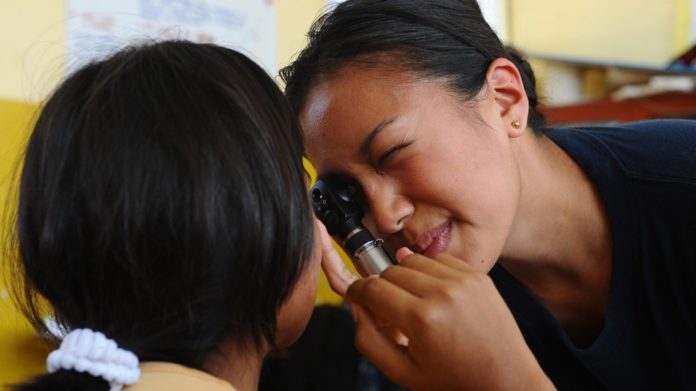Stem Cell Eye Treatment May Restore Vision

When stem cells were first culled from human embryos sixteen years ago, scientists imagined they would soon be treating diabetes, heart disease, stroke, and many other diseases with cells manufactured in the lab.
It’s all taken longer than they thought. But now, a Massachusetts biotech firm has reported results from the largest, and longest, human test of a treatment based on embryonic stem cells, saying it appears safe and may have partly restored vision to patients going blind from degenerative diseases.
Results of three-year study were described Tuesday in the Lancet by Advanced Cell Technology and collaborating eye specialists at the Jules Stein Eye Institute in Los Angeles who transplanted lab-grown cells into the eyes of nine people with macular degeneration and nine with Stargardt’s macular dystrophy.
The idea behind Advanced Cell’s treatment is to replace retinal pigment epithelium cells, known as RPE cells, a type of caretaker tissue without which a person’s photoreceptors also die, with supplies grown in laboratory. It uses embryonic stem cells as a starting point, coaxing them to generate millions of specialized retina cells. In the study, each patient received a transplant of between 50,000 and 150,000 of those cells into one eye.
The main objective of the study was to prove the cells were safe. Beyond seeing no worrisome side effects, the researchers also noted some improvements in the patients. According to the researchers half of them improved enough to read two to three extra lines on an eye exam chart, results Robert Lanza, chief scientific officer of Advanced Cell, called remarkable.
“We have people saying things no one would make up, like ‘Oh I can see the pattern on my furniture, or now I drive to the airport,” he says. “Clearly there is something going on here.”
Lanza stressed the need for a larger study, which he said the company hoped to launch later this year in Stargardt’s patients. But if the vision results seen so far continue, Lanza says “this would be a therapy.”
Some eye specialists said it’s too soon to say whether the vision improvements were real. The patients weren’t examined by independent specialists, they said, and eyesight in patients with low vision is notoriously difficult to measure. That leaves plenty of room for placebo effects or unconscious bias on the part of doctors.
“When someone gets a treatment, they try really hard to read the eye chart,” says Stephen Tsang, a doctor at Columbia University who sees patients losing their vision to both diseases. It’s common for patients to show quick improvements, he says, although typically not as large as what Advanced Cell is reporting.
Tsang also questions the some of the photographic evidence Advanced Cell said showed the transplanted cells had survived. “It’s a proof of concept that it’s safe, but otherwise it’s hard to reach any conclusion,” he says.
But favorable results are critical for Advanced Cell, a tiny biotech concern in Marlborough, Massachusetts, that has struggled financially. This year it was fined by stock market regulators and its CEO resigned amidst a stock-sale scandal. Lanza said a larger study to prove if the treatment works would “cost tens of millions.”
Perhaps because it needs to raise money, Advanced Cell has previously touted preliminary results from the study, including claiming that one patient, a rancher, essentially regained his vision. But for each such anecdote, there is another patient saying the treatment did nothing. One, Maurie Hill, who has Stargardt’s and has totally lost the central part of her vision, said on her blog that she was disappointed that she’d experienced no “functional change in vision.”
The Advanced Cell eye studies are important because they are the only clinical trials based on embryonic stem cells in the U.S. One other study, in spinal cord injury, was halted in 2011 when Geron, the company backing it, decided to cancel the program after treating five patients.
But because the eye is easier to treat, there could soon be small boom in retina studies using embryonic stem cells. The biotech company BioTime said this month that it had asked the Food & Drug Administration for approval to run a small clinical trial and the drug giant Pfizer plans to launch its own study, in which it would transplant larger patches of retinal cells. If that trial moves forward, it would be the first by a large pharmaceutical firm using embryonic stem cells.
“The rationale is clear,” says Magdalene Seiler, a researcher with the University of California, Irvine. “If you can replace the RPE cells you can rescue the photoreceptors. That has been shown over and over again in animal experiments.”
In September of this year, Japanese doctors performed the first transplant of retinal tissue derived from so-called “iPS” cells, which are stem cells that can be created from a person’s own tissue and which match them genetically.
- Obama’s Brain Project Backs Neurotechnology
- Vast Grassroots Mobile Network Grows at Center of Hong Kong Protests
- Saying Hello to Ello, an Ad-Free Facebook Alternative
- Why the Shellshock Bug Is Worse than Heartbleed
This article originally published at MIT Technology Review here

